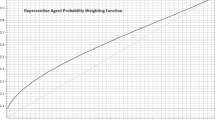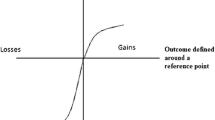Abstract
A number of classical as well as quite new utility representations for gains are explored with the aim of understanding the behavioral conditions that are necessary and sufficient for various subfamilies of successively stronger representations to hold. Among the utility representations are: ranked additive, weighted, rank-dependent (which includes cumulative prospect theory as a special case), gains decomposition, subjective expected, and independent increments*, where * denotes something new in this article. Among the key behavioral conditions are: idempotence, general event commutativity*, coalescing, gains decomposition, and component summing*. The structure of relations is sufficiently simple that certain key experiments are able to exclude entire classes of representations. For example, the class of rank-dependent utility models is very likely excluded because of empirical results about the failure of coalescing. Figures 1–3 summarize some of the primary results.
Similar content being viewed by others
References
Aczél, J. (1966). Lectures on Functional Equations and their Applications. New York: Academic Press.
Aczél, J. (1987). A Short Course on Functional Equations Based on Applications to the Behavioral and Social Sciences Dordrecht-Boston-Lancaster-Tokyo: Reidel-Kluwer.
Aczél, J. and M. Kuczma. (1991). “Generalizations of a ‘Folk-Theorem’ on Simple Functional Equations in a Single Variable,” Results in Mathematics 19, 5–21.
Aczél, J., R.D. Luce, and A.A.J. Marley. (2003). “A Functional Equation Arising from Simultaneous Utility Representations,” Results Math. 43, 193–197.
Anscombe, F.J. and R.J. Aumann. (1963). “A Definition of Subjective Probability,” Annals Math. Stat. 34, 199–205.
Birnbaum, M.H. (1997). “Violations of Monotonicity in Judgment and Decision Making.” In A.A.J. Marley (ed.). Choice, Decision, and Measurement: Essays in Honor of R. Duncan Luce. Mahwah, NJ: Erlbaum, pp. 73–100.
Birnbaum, M.H. (1999). “Paradoxes of Allais, Stochastic Dominance, and Decision Weights.” In J. Shanteau, B. A. Mellers, and D.A. Schum (eds.), Decision Science and Technology: Reflections on the Contributions of Ward Edwards. Norwell, MA: Kluwer Academic Publishers, pp. 27–52.
Birnbaum, M.H. (2000). “Decision Making in the Lab and on the Web.” In M. H. Birnbaum (ed.). Psychological Experiments on the Internet. San Diego, CA: Academic Press, pp. 3–34.
Birnbaum, M.H. (2004). “Tests of Rank-Dependent Utility and Cumulative Prospect Theory in Gambles Represented by Natural Frequencies: Effects of Format, Event Framing, and Branch Splitting,”Organizational Behavior and Human Decision Processes 95, 40–65.
Birnbaum, M.H. and D. Beeghley. (1997). “Violations of Branch Independence in Judgments of the Value of Gambles,” Psychological Science 8, 87–94.
Birnbaum, M.H. and A. Chavez. (1997). “Tests of Theories of Decision Making: Violations of Branch Independence and Distribution Independence,” Organizational Behavior and Human Decision Processes 71, 161–194.
Birnbaum, M.H., G. Coffey, B.A. Mellers, and R. Weiss. (1992). “Utility Measurement: Configural-Weight Theory and the Judge’s Point of View,” Journal of Experimental Psychology: Human Perception and Performance 18, 331–346.
Birnbaum, M.H., and J. Navarrete. (1998). “Testing Descriptive Utility Theories: Violations of Stochastic Dominance and Cumulative Independence,” Journal of Risk and Uncertainty 17, 49–78.
Casadesus-Masanell, R., P. Klibanoff, and E. Ozdenoren. (2000). “Maxmin Expected Utility over Savage Acts with a Set of Priors,” J. Econ. Theory 92, 35–65.
Chew, S.H. (1983). “A Generalization of the Quasilinear Mean and Applications to the Measurement of Income Inequality and Decision Theory Resolving the Allais Paradox,” Econometrica 51, 1065–1092.
Cho, Y.-H., R.D. Luce, and L. Truong. (2002). “Duplex Decomposition and General Segregation of Lotteries of a Gain and a Loss: An Empirical Evaluation,” Org. Beh. Hum. Dec. Making 89, 1176–1193.
Choquet, G. (1953). “Theory of Capacities,” Annales Inst. Fourier 5, 131–295.
Ellsberg, D. (1961). “Risk, Ambiguity, and the Savage Axioms,” Q. J. Econ. 75, 643–669.
Fishburn, P.C. (1988). Nonlinear Preference and Utility Theory. Baltimore, MD: Johns Hopkins Press.
Ghirardato, P. and M. Marinacci. (2002). “Ambiguity Made Precise: A Comparative Foundation,” J. Econ. Theory 102, 251–289.
Ghirardato, P., F. Maccheroni, M. Marinacci, and M. Siniscalchi. (2003). “A Subjective Spin on Roulette Wheels,” Econometrica 71, 1897–1908.
Gilboa, I., and D. Schmeidler. (1989). “Maxmin Expected Utility with a Non-Unique Prior,” J. Math. Econ. 18, 141–153.
Kahneman, D. and A. Tversky. (1979). “Prospect Theory: An Analysis of Decision Making Under Risk,” Econometrica 47, 263–291.
Karmarkar, U.S. (1978). “Subjectively Weighted Utility: A Descriptive Extension of the Expected Utility Model,” Org. Beh. Human Performance 21, 61–72.
Köbberling, V. and P.P. Wakker. (2003). “Preference Foundations for Nonexpected Utility: A Generalized and Simplified Technique,” Math. Op. Res. 28, 395–423.
Krantz, D. H., R.D. Luce, P. Suppes, and A. Tversky. (1971). Foundations of Measurement, Vol. I. San Diego: Academic Press.
Liu, L. (1995). A Theory of Coarse Utility and its Application to Portfolio Analysis. University of Kansas, Ph.D. dissertation.
Luce, R.D. (1959). Individual Choice Behavior: A Theoretical Analysis. New York: Wiley.
Luce, R.D. (1990). “Rational versus Plausible Accounting Equivalences in Preference Judgments,” Psychol. Sci. 1, 225–234.
Luce, R.D. (1998). “Coalescing, Event Commutativity, and Theories of Utility,” J. Risk Uncert. 16, 87–114. Errata: 18, 1999, 99.
Luce, R.D. (2000). Utility of Gains and Losses: Measurement-Theoretical and Experimental Approaches. Mahwah, NJ: Erlbaum, Errata: see Luce’s web page at http://www.socsci.uci.edu
Luce, R.D. (2002). “A Psychophysical Theory of Intensity Proportions, Joint Presentations, and Matches,” Psych. Rev. 109, 520–532.
Luce, R.D. (2003). “Increasing Increment Generalizations of Rank-Dependent Theories,” Theory Dec. 55, 87–146.
Luce, R.D. (2004). “Symmetric and Asymmetric Matching of Joint Presentations,” Psych. Rev. 111, 446–454.
Luce, R.D. and A.A.J. Marley. (2000). “Elements of Chance,” Theory Dec. 49, 97–126.
Maksa, G. (1999). “Solution of Generalized Bisymmetry Type Equations Without Surjectivity Assumptions,” Aequationes Math. 57, 50–74.
Marley, A.A.J. and R.D. Luce. (2001). “Ranked-Weighted Utility and Qualitative Convolution,” J. Risk Uncert. 23, 135–163.
Marley, A.A.J. and R.D. Luce. (2004). “Independence Properties vis-à-vis Several Utility Representations,” submitted.
Meginniss, J.R. (1976). “A New Class of Symmetric Utility Rules for Gambles, Subjective Marginal Probability Functions, and a Generalized Bayes’ Rule,” Proceedings American Statistical Association, Business and Economic Statistics Sec. 471–476.
Ng, C.T. (2003). “Monotonic Solutions of Functional Equation Arising from Simultaneous Utility Representations,”Results in Mathematics 44, 340–361.
Quiggin, J. (1982). “ A Theory of Anticipated Utility,” J. Econ. Beh. Org. 3, 323–343.
Quiggin, J. (1993). Generalized Expected Utility Theory: The Rank-Dependent Model. Boston: Kluwer Academic Publishers.
Savage, L.J. (1954). The Foundations of Statistics. New York: Wiley.
Schmeidler, D. (1989). “Subjective Probability and Expected Utility Without Additivity,” Econometrica 57, 571–587.
Slovic, P., M. Finucane, E. Peters, and D.G. MacGregor. (2002). “The Affect Heuristic.” In T. Gilovich, D. Griffin, and D. Kahneman (eds.), Heuristics and Biases: The Psychology of Intuitive Judgment. New York: Cambridge University Press, pp. 397–420.
Tversky, A. and D. Kahneman. (1992). “Advances in Prospect Theory: Cumulative Representation of Uncertainty,” J. Risk Uncert. 5, 297–323.
von Neumann, J. and O.Morgenstern. (1947). Theory of Games and Economic Behavior, 2nd edition. Princeton, NJ: Princeton University Press.
Wakker, P. P. (1990). “Under Stochastic Dominance Choquet-Expected Utility and Anticipated Utility are Identical,” Theory and Decision 119–132.
Wakker, P.P. (1991). “Additive Representations on Rank-Ordered Sets. I. The Algebraic Approach,” J. Math. Psych. 35, 501–531.
Wang, T. (2003). “Conditional Preferences and Updating,” J. Econ. Theory 108, 286–321.
Author information
Authors and Affiliations
Corresponding author
Additional information
JEL Classification
D46, D81
Rights and permissions
About this article
Cite this article
Luce, R.D., Marley, A.A.J. Ranked Additive Utility Representations of Gambles: Old and New Axiomatizations. J Risk Uncertainty 30, 21–62 (2005). https://doi.org/10.1007/s11166-005-5832-9
Issue Date:
DOI: https://doi.org/10.1007/s11166-005-5832-9




